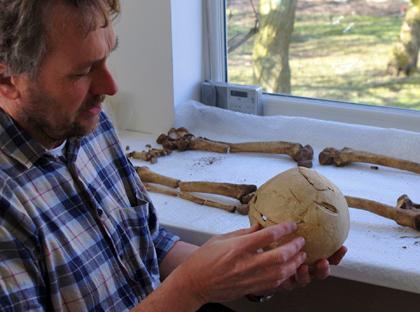Ben Miller
Source - http://www.culture24.org.uk/history-and-heritage/archaeology/art482014-Skeleton-executed-by-sword-head-surprises-archaeologists-investigating-Norman-Conquest
An unusual set of battlefield burials have led to the skeleton of the first ever human discovery directly related to the 11th century Norman Conquest

A potentially groundbreaking discovery has been announced as part of the 750th anniversary commemorations of the Battle of Lewes in Sussex© Courtesy Sussex Archaeological Society
A brutally-murdered man, executed by six sword blows to the back of the skull during a vicious 11th century battle on hospital grounds in Sussex, is compelling archaeologists to reconsider Norman war burials after becoming the first ever skeleton to be related to the 1066 invasion.
Originally discovered during a dig at a former medieval hospital more than 20 years ago, the individual has been carbon dated to within 28 years of 1063.
“The first injury was probably a cut to the right side of the ear and upper jaw,” says Malin Holst, an osteoarchaeologist from the University of York who was commissioned to examine the skeleton by the Sussex Archaeological Society.
“This was then followed by a series of sword cuts, all delivered from the left hand side behind the victim, in a downward and horizontal motion.
“He ate a diet particularly rich in marine fish. He had some spinal abnormalities and suffered from chronic infection of the sinuses.
“He showed age-related wear and tear of the joints of his spine, shoulders and left wrist, which might have been uncomfortable.
“He had lost a few teeth during life, possibly as a result of receding gums. He had two small tumours on his skull.”
Thought to have been at least 45, the man had already suffered a head wound during the two years before his violent death.
“He had sustained an injury to the left temple which caused a blood clot to form,” explains Holst.
“It was well-healed at the time of his death.”
Luke Barber, of the Society, co-directed the excavation which found the body.
“Very little was known about the medieval hospital of St Nicholas Lewes until the excavations in 1994 by Archaeology South East uncovered part of its cemetery,” he says.
“Among the 103 excavated skeletons a handful of individuals had a traumatic death, although skeleton 180 stood out.
“Reinterpretation of the Battle of Lewes [in 1264] had put the hospital at the epicentre of the fiercest fighting.”
Barber says the results “certainly weren’t what we were expecting”.
“It shows the value of keeping an open mind about things, especially where there’s a puzzle which doesn’t quite make sense, as there was in this case.
“Long after an excavation has been carried out new research and analysis can still shed further light on a site.”
Casper Johnson, the Senior Archaeologist for East Sussex Council, believes other skeletons from the site could be associated with the battle on its 750th anniversary.
“This could shed new light on what happened in Lewes at the time of the Norman invasion,” he believes. “But further dating of the skeletons is needed.
“Other skeletons may come from a later period. We could be looking at a very complex picture.”
An exhibition about the hospital and the research is planned for the castle later this year.
“This research is refreshing in the true sense of the word,” says Tim Sutherland, of the York team.
“So much of our existing history and data is taken for granted that it is often difficult to see it in anything approaching a different manner.
“But here a remarkable new story could be unfolding thanks to up-to-date technology, methods and expertise.”